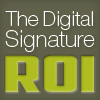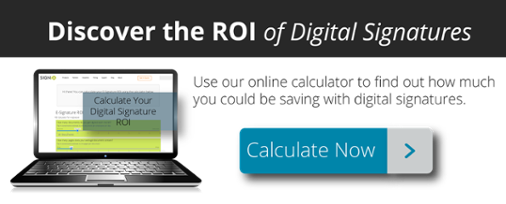 The US ESIGN Act, signed in 2000, defines an electronic signature as:
The US ESIGN Act, signed in 2000, defines an electronic signature as:
“…an electronic sound, symbol, or process, attached to or logically associated with a contract or other record and executed or adopted by a person with the intent to sign the record.”
This is great from a legal and technological perspective, but the real definition of an electronic signature should read:
“…a tool designed to more securely replace wet ink signatures that radically speeds up business processes, destroys inefficiency, lowers costs, and makes for more productive employees.”
That latter piece—making employees more productive with digital signatures—is what we’re going to throw a few details behind in this next segment of our Digital Signature ROI blog series.
Let’s think about how employee productivity is affected in a typical business that’s built on wet ink signed documents. Relying on these signatures to close business means that you must have staff dedicated to keeping the paper flowing smoothly. Companies risk customer flight if they can’t keep these processes under control. This means personnel hired for:
- Sending documents out;
- Keeping track of who was sent what when;
- Chasing down lagging signers;
- Resending documents to folks that misplaced documents / never received them;
- Opening envelopes when documents are returned;
- Looking at the documents to be sure all the signature and initial fields are filled out, let alone checking that all the other required information has been filled in;
- Assigning document ID numbers to paperwork;
- Filing the paperwork and/or scanning in the paper documents into a document repository or archive; and (breathe)
- Re-keying information from a signed paper form back into an electronic system!
The proliferation of electronic forms and documents has eliminated some of the problems above. However, the promise of straight-through processing (STP)—in other words, a fully electronic, end-to-end solution—is incomplete without electronic signatures. A majority of forms today are easily filled in on a computer, but then are printed out in order to be signed with a pen. These documents then need to be re-scanned and emailed, faxed, or sent via snail mail back to the company they originated from. And at that point, employees again have to take up the slack: confirming signatures, scanning barcodes, and rescanning documents back into an electronic system. It’s such a waste!
Compounding this are organizations where order and sales staff collect signed paper contracts and forms and send them in bulk at the end of the week to a central office, maximizing the pressure on the receiving end and further reducing productivity.
Deploying electronic signatures into your organization means that you can get signed documents from the customer immediately, and move to real straight-through processing. Surely, you can’t eliminate paper completely, as legally you must provide an option for clients to opt out of electronic signatures, but deploying digital signatures means that a majority of the employees dedicated to paper processing are suddenly freed up.
Why? Electronic signature solutions like SIGNiX take on all of the tasks typically performed by these masses of employees by allowing companies to...
- send out and route documents for signature to multiple parties;
- govern who signs what and when;
- see at any time where documents are in the signing process;
- send out reminders to signers who aren’t signing in a timely fashion;
- authenticate signers’ identities at signature (a step sometimes skipped in the paper world);
- ensure that signers are signing and completing mandatory fields; and
- collect electronic copies of forms that can be input directly back into a company’s systems of record, eliminating re-keying requirements;
…all via an online, SaaS model. No specialized personnel, no hardware, no software to install, and no infrastructure to maintain.
Companies can then re-deploy full-time employees devoted to these tasks into more productive roles or allow employees to focus on the critical aspects of their work (i.e. keeping track of specific contract requirements) rather than just moving paper. In fact, some organizations actually hire temporary staff simply to handle influxes of paper at peak times of the year when forms are returned. Electronic signatures can eliminate the need to hire these additional workers and make for a better use of hard-earned profits.
Often, the sales department takes on the responsibility for calling and bugging clients to check their inboxes and mailrooms for contracts to sign. Relying on electronic signature systems means that your salespeople can spend more time in the field crafting and developing relationships, becoming more revenue productive in the process.
When you consider businesses in the investment, realty, or insurance industries where forms move through a complex, multi-step process of reviews, approvals and signatures before transactions are finally set in motion, the productivity and efficiency gains won through electronic signature systems are multiplied several times.
While traditional electronic signature ROI tends to focus on eliminating overnight deliveries, all of these productivity gains also result in a substantial return on investment for the implementing organization.
Digital signature solutions like SIGNiX provide your company with the ability to unlock untold efficiency gains and enable you to foster a more productive workforce. In our next entry for the Digital Signature ROI series, we’ll talk about how electronic signatures can reduce drag on your revenues.
%20formatted-1.png?width=2528&height=739&name=SIGNiX%20Logo%20Main%20(white)%20formatted-1.png)

